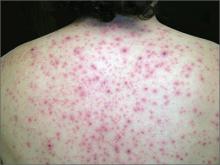The FP diagnosed a varicella infection in this patient. The simultaneous appearance of papules, pustules, and crusted lesions on the patient’s trunk and face was highly suspicious for varicella, especially because there was no history of him receiving the varicella vaccine.
Varicella (chickenpox) is caused by a primary infection with the varicella zoster virus (VZV), which is a double-stranded, linear DNA herpes virus. Transmission occurs via contact with aerosolized droplets from nasopharyngeal secretions or by direct cutaneous contact with vesicle fluid from skin lesions. The incubation period for VZV is approximately 15 days, during which the virus undergoes replication in regional lymph nodes, followed by 2 viremic stages. In the first stage the virus spreads to internal organs, and in the second stage the virus spreads to the skin.
The vesicular rash appears in crops for several days and the lesions start as vesicles on a red base (classically described as a “dew drop on a rose petal”). The lesions gradually develop a pustular component followed by the evolution of crusted papules. The period of infectivity is generally considered to last from 48 hours prior to the onset of the rash until the skin lesions have fully crusted.
New varicella lesions stop forming in approximately 4 days, and most lesions become fully crusted by 7 days. Diagnosis is usually based on classic presentation. A culture of the lesions may provide a definitive diagnosis, but is positive in less than 40% of cases. Direct fluorescent antibody testing has good sensitivity and is more rapid than tissue culture. In this case, the diagnosis was made on clinical grounds.
Adults who get varicella should be assessed for neurologic and pulmonary disease; our patient showed no signs of either complication. Encephalitis is a serious potential complication of chickenpox that can develop toward the end of the first week of the exanthema. One form, acute cerebellar ataxia, occurs mostly in children and is generally followed by a complete recovery. In adults, a diffuse encephalitis can occur, and may produce delirium, seizures, and focal neurologic signs. It has significant rates of long-term neurologic sequelae and death.
Varicella pneumonia accounts for the majority of hospitalizations in adults with chickenpox, where it has up to a 30% mortality rate. It usually develops insidiously within a few days after the rash has appeared, with progressive tachypnea, dyspnea, and dry cough. Chest x-rays will reveal diffuse bilateral infiltrates. Varicella pneumonia requires prompt administration of intravenous acyclovir.
For adults with uncomplicated varicella, oral acyclovir 800 mg 5 times/d for 5 days may be used for treatment if started within the first 24 hours of the rash. The patient in this case denied risk factors for human immunodeficiency virus, and because he lacked health insurance, he did not want any blood tests or medications unless they were absolutely necessary. He wanted to return to work but was told that he needed to wait until all his lesions had crusted over.
Photos and text for Photo Rounds Friday courtesy of Richard P. Usatine, MD. This case was adapted from: Mayeaux EJ. Chickenpox. In: Usatine R, Smith M, Mayeaux EJ, et al, eds. Color Atlas of Family Medicine. 2nd ed. New York, NY: McGraw-Hill; 2013:707-711.
To learn more about the Color Atlas of Family Medicine, see: www.amazon.com/Color-Family-Medicine-Richard-Usatine/dp/0071769641/
You can now get the second edition of the Color Atlas of Family Medicine as an app by clicking on this link: usatinemedia.com


